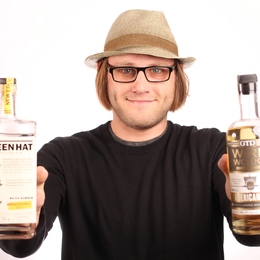
Matt Teacher has his hands in a lot of pots, so to speak. Ask the Philadelphia native to explain what he does for a living and he’ll describe himself as “one part writer, one part musician and recording-studio owner.”
At Sine Studios in Philly’s historic Rittenhouse district, Teacher has been producing and engineering music for local and national acts since 2006. His creativity, however, doesn’t end with his work behind the soundboard. He writes books, including the 2011 tome, “The Home Distiller’s Handbook.” He plays bass in a band called Dirty Holiday, fronted by Philadelphia talent Katie Barbato. And he writes songs, including the title track for “Sugar,” a 2013 feature film about homeless youths living on the streets of Venice, Calif., which he co-wrote with Barbato.
Teacher’s most recent product—“The Spirit of Gin: A Stirring Miscellany of the New Gin Revival”—is a follow-up to his first spirits book, only this time he explores the resurgence of one spirit in particular. Due out next month from Cider Mill Press, the book includes more than 40 cocktail recipes, as well as a comprehensive catalog of more than 160 gin distillers from around the world.
We spoke with Teacher about his latest work, including the trends behind gin’s return to the limelight and why gin aficionados are so passionate about their spirit of choice. Perhaps most importantly, he also shared his list of favorite places in Philadelphia to partake in a proper tipple.
Cocktails in general have had a huge resurgence not just in Philadelphia but across the country. What other factors have contributed to gin’s revival?
As I see it, the biggest trend that invigorated the love and appreciation of gin is the farm-to-table, or farm-to bottle, movement. Today, people are becoming increasingly interested in where the products they put in their bodies come from and how they were grown. This is not limited to food. What makes gin the perfect candidate for this mentality is that it can be created from a wide range of both local and exotic botanicals. As I toured distilleries and spoke with gin masters, I kept hearing the same thing: “The quality of every single ingredient that goes into a gin is important and must be carefully selected—the water source, the grain or other source fermenter, and all the ingredients that comprise the end product’s flavor.”
Another reason gin is popular with many distilleries today is that, unlike a spirit such as whiskey, a distiller is able to start producing and selling their spirit immediately. I’ve spoken with quite a few distillers who told me of their plans to branch out into the whiskey market or already have whiskey aging in barrels, waiting for their maturation. I wouldn’t be surprised if whiskey got another boom in a few years.
What is it about gin that stirs such passion among aficionados such as yourself?
I can remember the first time my dad made me a martini. I instantly fell in love with the whole cocktail creation process: chilling the glass; selecting a gin and vermouth; experimenting with ratios; stirring versus shaking; garnishment. Of all cocktails, the martini was always king for me. Time went by with a limited gin selection and it was always Tanqueray 10 or Beefeater for me. Then, as I saw more and more gins coming to market and what great mixologists were able to create with them, my head began to swarm with the endless possibilities.
Gin is an exciting libation due to its very nature; the diverse abundance of potential ingredients makes it truly unique. Whereas vodka rarely imparts any sort of flavor to a cocktail—it is overwhelmed and masked by the other cocktail ingredients—a good gin has the capability to really shine. These days I’m always trying to convince friends that are stuck with the “gin tastes like pine trees” memory that there are many new and exciting variations out there today. I’ve even succeeded in converting a few.
A press release about your forthcoming book makes mention of “celebrated clubs” and “bars and top mixologists passionate about the spirit.” Are any of these based in the Philadelphia area?
While there are no Philadelphia-based venues featured in “The Spirit of Gin,” there is a feature written about a gin tasting I held with renowned Philadelphia mixologist Katie Loeb. Having featured a good number of personal Philly favorites in my previous book (“The Home Distiller’s Handbook”), I wanted this book to capture the global scale of the gin revival and for that reason I felt it was important to step out of my bounds, reach out and travel.
Having said that, there are some that are not too far from home: New York City’s Gin Palace and Washington, D.C.’s Wisdom. Philadelphia does have a wonderful and growing cocktail culture, and some of my favorite gin tipples can be found at venues such as Positano Coast, 1 Tippling Place, the Franklin Mortgage & Investment Co. and the Ranstead Room.
Photograph by Descano Photography


